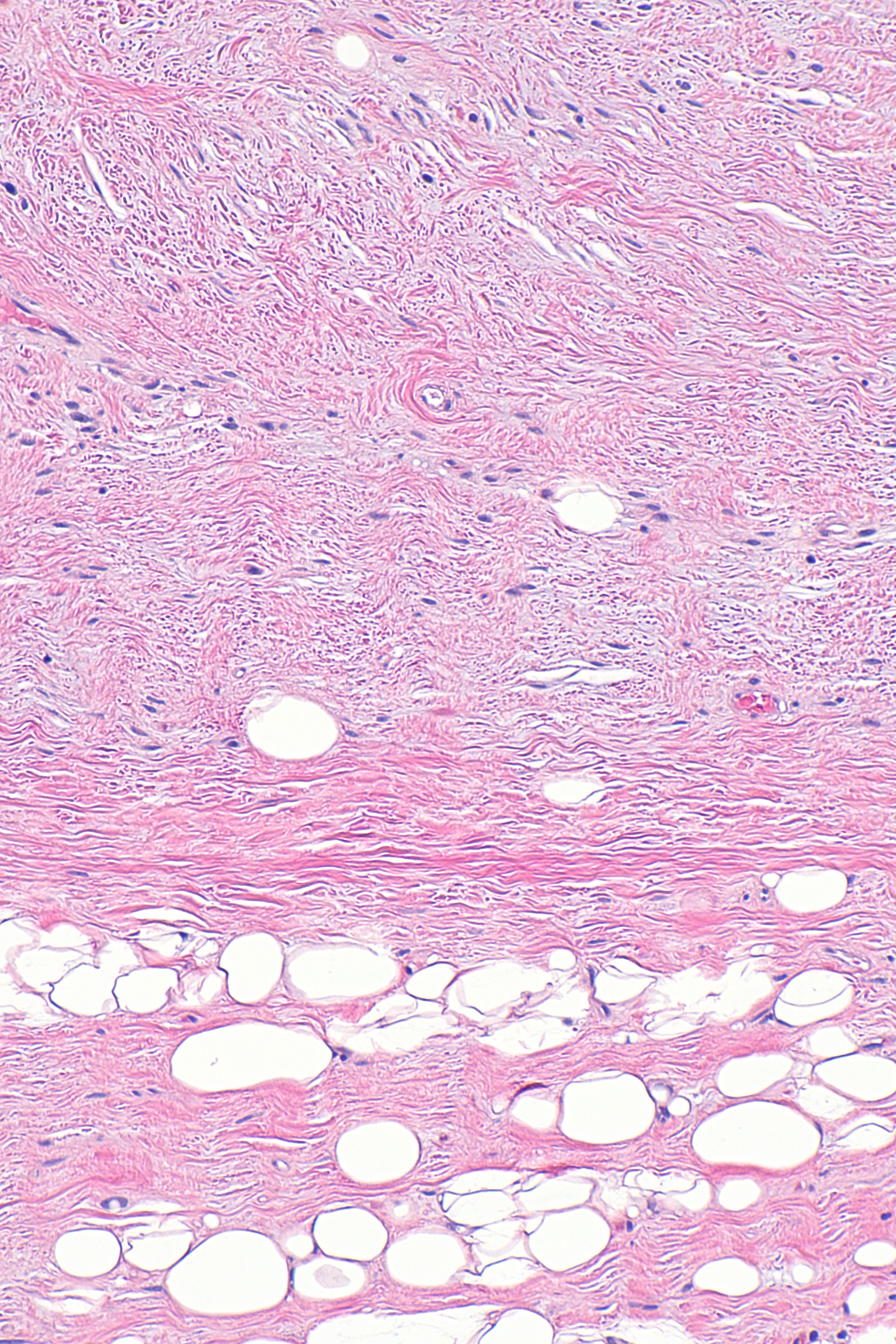Lipoma pathophysiology
|
Lipoma Microchapters |
|
Diagnosis |
|---|
|
Treatment |
|
Case Studies |
|
Lipoma pathophysiology On the Web |
|
American Roentgen Ray Society Images of Lipoma pathophysiology |
|
Risk calculators and risk factors for Lipoma pathophysiology |
Editor-In-Chief: C. Michael Gibson, M.S., M.D. [1] Associate Editor(s)-in-Chief: Sahar Memar Montazerin, M.D.[2]
Overview
Lipoma is formed from mature adipocyte cells and is histologically indistinguishable from fat tissue. Recent studies have observed cytogenetic abnormalities in 50-60% of lipomas, suggesting its role in the lipoma pathogenesis. Rearrangements of chromosome 12 are the most commonly cytogenetic abnormality. In a cross-sectional appearance, the lipoma is pale yellow to orange and has a uniform greasy surface with a lobular pattern. The subcutaneous lipoma is usually encapsulated and has a distinct lobulated pattern.
Pathophysiology
- Lipoma is formed from mature adipocytes and is histologically indistinguishable from fat tissue.
- Recent studies have observed cytogenetic abnormalities in 50-60% of lipomas, suggesting its role in the lipoma pathogenesis.[1][2]
- Rearrangements of chromosome 12 is the most commonly cytogenetic abnormality.
- The DDIT3 gene, located on the long arm of chromosome 12, has been suggested to play a role in adipocytic differentiation.[3]
- This gene encodes a protein family, known to be enhancer binding protein.
- Members of this protein family are highly expressed in fat and are engaged in the growth arrest of fat cells.
Genetics
- Genetic abnormalities associated with lipoma pathogenesis include:[4]
- Translocations in 12q13-15
- Interstitial deletions of 13q
- Rearrangements in 6p21-23
Gross pathology
- Gross pathology of lipoma may differ depending on anatomical location.[5]
- Subcutaneous lipoma appear as a a soft, well-circumscribed rounded mass with different size ranging from millimeters to 5 cm or more.
- Lipomas larger than 10 cm are not common.
- In cross-sectional appearance, the lipoma is pale yellow to orange and has a uniform greasy surface with a lobular pattern.
- Lipoma is usually encapsulated.
- Focal hemorrhage or fat necrosis may also occur, but it is much less common than in liposarcomas.
- Intramuscular lipomas are usually larger than subcutaneous lipomas and may be encapsulated or diffuse.[6]
- Grayish streaks of fibrous tissue may also be seen in fibrolipoma which has a firmer texture compared to ordinary lipoma.

Microscopic pathology
- Microscopically, lipomas are formed from mature fat cells.[8]
- There is no nuclear hyperchromasia.
- Subcutaneous lipoma is usually encapsulated and have a distinct lobulated pattern.
- Cystic like changes may also be seen in lipoma due to impaired blood supply.
- Infection or trauma may cause fat necrosis or local liquefaction of fat, which may appear with phagocytic cells and formation of lipid cysts.
- A possible benign finding in lipoma is the collection of histiocytes and the vacuolization of the nucleus.[9]
- Intramuscular lipoma may be well-demarcated from the adjacent muscular tissue or have a diffuse pattern with alternating adipocytes and skeletal muscle cells.


Immunohistochemistry
- Lipomas may have following immunohistochemical markers:[12]
Gallery
-
Histopathologic slide of renal angiomyolipoma. Nephrectomy specimen. H & E stain.[13]
-
Histopathologic slide of renal angiomyolipoma. Nephrectomy specimen. H & E stain.[13]
-
Histopathologic slide of renal angiomyolipoma. Nephrectomy specimen. H & E stain.[13]
-
Histopathologic image of renal angiomyolipoma. Nephrectomy specimen. HMB-45 immunostain.[13]
References
- ↑ Sreekantaiah C, Leong SP, Karakousis CP, McGee DL, Rappaport WD, Villar HV, Neal D, Fleming S, Wankel A, Herrington PN (January 1991). "Cytogenetic profile of 109 lipomas". Cancer Res. 51 (1): 422–33. PMID 1988102.
- ↑ Weiss SW (1996). "Lipomatous tumors". Monogr Pathol. 38: 207–39. PMID 8744279.
- ↑ Adelmant G, Gilbert JD, Freytag SO (June 1998). "Human translocation liposarcoma-CCAAT/enhancer binding protein (C/EBP) homologous protein (TLS-CHOP) oncoprotein prevents adipocyte differentiation by directly interfering with C/EBPbeta function". J. Biol. Chem. 273 (25): 15574–81. doi:10.1074/jbc.273.25.15574. PMID 9624148.
- ↑ Willén, Helena; Åkerman, Måns; Dal Cin, Paola; De Wever, Ivo; Fletcher, Christopher D.M; Mandahl, Nils; Mertens, Fredrik; Mitelman, Felix; Rosai, Juan; Rydholm, Anders; Sciot, Raf; Tallini, Giovanni; Van Den Berghe, Herman; Vanni, Roberta (1998). "Comparison of Chromosomal Patterns with Clinical Features in 165 Lipomas: A Report of the CHAMP Study Group". Cancer Genetics and Cytogenetics. 102 (1): 46–49. doi:10.1016/S0165-4608(97)00292-6. ISSN 0165-4608.
- ↑ Miettinen, Markku (2010). Modern soft tissue pathology : tumors and non-neoplastic conditions. Cambridge New York: Cambridge University Press. ISBN 9780521874090.
- ↑ Miettinen, Markku (2010). Modern soft tissue pathology : tumors and non-neoplastic conditions. Cambridge New York: Cambridge University Press. ISBN 9780521874090.
- ↑ Image courtesy of Sebastian E Valbuena, Greg A O'Toole and Eric Roulot, wikimedia commons
- ↑ Simango, Stephen; Ramdial, Pratistadevi K.; Madaree, Anil (2000). "Subpectoral post-traumatic lipoma". British Journal of Plastic Surgery. 53 (7): 627–629. doi:10.1054/bjps.2000.3396. ISSN 0007-1226.
- ↑ Miettinen, Markku (2010). Modern soft tissue pathology : tumors and non-neoplastic conditions. Cambridge New York: Cambridge University Press. ISBN 9780521874090.
- ↑ wikimedia commons
- ↑ Pathological and histological images courtesy of Ed Uthman at flickr, wikimedia commons
- ↑ Fletcher, Christopher (2002). Pathology and genetics of tumours of soft tissue and bone. Lyon: IARC Press. ISBN 9283224132.
- ↑ 13.0 13.1 13.2 13.3 http://librepathology.org/wiki/index.php/Angiomyolipoma
![Histopathologic slide of renal angiomyolipoma. Nephrectomy specimen. H & E stain.[13]](/images/a/a3/Renal_angiomyolipoma_%281%29.jpg)
![Histopathologic slide of renal angiomyolipoma. Nephrectomy specimen. H & E stain.[13]](/images/b/be/Renal_angiomyolipoma_%282%29.jpg)
![Histopathologic slide of renal angiomyolipoma. Nephrectomy specimen. H & E stain.[13]](/images/d/d2/Renal_angiomyolipoma_%283%29.jpg)
![Histopathologic image of renal angiomyolipoma. Nephrectomy specimen. HMB-45 immunostain.[13]](/images/0/07/Renal_angiomyolipoma_%284%29_HMB-45_immunostain.JPG)